Turbulent Momentum Flux Behavior above a Fire Front in an Open-Canopied Forest
Abstract
:1. Introduction
2. Materials and Methods
2.1. Site Description
2.2. Atmospheric and Fire Spread Monitoring Network
2.3. Prescribed Fire Description
2.4. Data Processing
2.5. Sweep-Ejection Dynamics Analysis
3. Results
3.1. Ambient and Fire-Induced Meteorology
3.2. Momentum-Flux Sweep-Ejection Dynamics
3.3. Periodicity of Momentum-Flux Events
4. Discussion
5. Conclusions
Author Contributions
Funding
Institutional Review Board Statement
Informed Consent Statement
Data Availability Statement
Acknowledgments
Conflicts of Interest
References
- Clements, C.B.; Zhong, S.; Goodrick, S.; Li, J.; Potter, B.E.; Bian, X.; Heilman, W.E.; Charney, J.J.; Perna, R.; Jang, M.; et al. Observing the dynamics of wildland grass fires: FireFlux—A field validation experiment. Bull. Am. Meteorol. Soc. 2007, 88, 1369–1382. [Google Scholar] [CrossRef] [Green Version]
- Clements, C.B.; Kochanski, A.K.; Seto, D.; Davis, B.; Camacho, C.; Lareau, N.P.; Contezac, J.; Restaino, J.; Heilman, W.E.; Krueger, S.K.; et al. The FireFlux II experiment: A model-guided field experiment to improve understanding of fire–atmosphere interactions and fire spread. Int. J. Wildland Fire 2019, 28, 308–326. [Google Scholar] [CrossRef] [Green Version]
- Heilman, W.E.; Zhong, S.; Hom, J.L.; Charney, J.J.; Kiefer, M.T.; Clark, K.L.; Skowronski, N.; Bohrer, G.; Lu, W.; Liu, Y.; et al. Development of modeling tools for predicting smoke dispersion from low-intensity fires. In Final Report, U.S. Joint Fire Science Program, Project 09-1-04-1, U.S. Joint Fire Science Program, Boise, Idaho, USA; 2013. Available online: http://www.firescience.gov/projects/09-1-04-1/project/09-1-04-1_final_report.pdf (accessed on 9 September 2020).
- Strand, T.M.; Rorig, M.; Yedinak, K.; Seto, D.; Allwine, E.; Garcia, F.A.; O’Keefe, P.; Checan, V.C.; Mickler, R.; Clements, C.; et al. Sub-canopy transport and dispersion of smoke: A unique observation dataset and model evaluation. In Final Report, U.S. Joint Fire Science Program, Project 09-1-04-2, U.S. Joint Fire Science Program, Boise, Idaho, USA; 2013. Available online: https://www.frames.gov/catalog/14498 (accessed on 9 September 2020).
- Seto, D.; Clements, C.B.; Heilman, W.E. Turbulence spectra measured during fire front passage. Agric. For. Meteorol. 2013, 169, 195–210. [Google Scholar] [CrossRef]
- Seto, D.; Strand, T.M.; Clements, C.B.; Thistle, H.; Mickler, R. Wind and plume thermodynamic structures during low-intensity subcanopy fires. Agric. For. Meteorol. 2014, 198–199, 53–61. [Google Scholar] [CrossRef]
- Houssami, M.; Mueller, E.; Thomas, J.C.; Simeoni, A.; Filkov, A.; Skowronski, N.; Gallagher, M.R.; Kremens, R. Experimental procedures characterising firebrand generation in wildland fires. Fire Technol. 2016, 52, 731–751. [Google Scholar] [CrossRef]
- Ottmar, R.D.; Hiers, J.K.; Butler, B.W.; Clements, C.B.; Dickinson, M.B.; Hudak, A.T.; O’Brien, J.J.; Potter, B.E.; Rowell, E.M.; Strand, T.M.; et al. Measurements, datasets and preliminary results from the RxCADRE project—2008, 2011 and 2012. Int. J. Wildland Fire 2016, 25, 1–9. [Google Scholar] [CrossRef]
- Clark, K.L.; Heilman, W.E.; Skowronski, N.S.; Gallagher, M.R.; Mueller, E.; Hadden, R.; Simeoni, A. Fire behavior, fuel consumption, and turbulence and energy exchange during prescribed fires in pitch pine forests. Atmosphere 2020, 11, 242. [Google Scholar] [CrossRef] [Green Version]
- Orlanski, I. A rational subdivision of scales for atmospheric processes. Bull. Am. Meteorol. Soc. 1975, 56, 527–530. [Google Scholar] [CrossRef]
- Stull, R.B. An Introduction to Boundary Layer Meteorology; Kluwer Academic: Dordrecht, The Netherlands, 1988; 666p. [Google Scholar]
- Rothermel, R.C. How to Predict the Spread and Intensity of Forest and Range Fires; USDA Forest Service, General Technical Report INT-143, Intermountain Forest and Range Experiment Station: Ogden, UT, USA, 1983; 161p. [Google Scholar]
- Simard, A.J. Fire severity, changing scales, and how things hang together. Int. J. Wildland Fire 1991, 1, 23–34. [Google Scholar] [CrossRef]
- Falk, D.A.; Miller, C.; McKenzie, D.; Black, A.E. Cross-scale analysis of fire regimes. Ecosystems 2007, 10, 809–823. [Google Scholar] [CrossRef] [Green Version]
- Clements, C.B.; Zhong, S.; Bian, X.; Heilman, W.E.; Byun, D.W. First observations of turbulence generated by grass fires. J. Geophys. Res. 2008, 113, D22102. [Google Scholar] [CrossRef] [Green Version]
- Sun, R.; Krueger, S.K.; Jenkins, M.A.; Zulauf, M.A.; Charney, J.J. The importance of fire–atmosphere coupling and boundary-layer turbulence to wildfire spread. Int. J. Wildland Fire 2009, 18, 50–60. [Google Scholar] [CrossRef]
- Seto, D.; Clements, C.B. Fire whirl evolution observed during a valley wind-sea breeze reversal. J. Combust. 2011, 2011, 569475. [Google Scholar] [CrossRef] [Green Version]
- Pimont, F.; Dupuy, J.-L.; Linn, R.R.; Dupont, S. Impacts of tree canopy structure on wind flows and fire propagation simulated with FIRETEC. Ann. For. Sci. 2011, 68, 523–530. [Google Scholar] [CrossRef] [Green Version]
- Pimont, F.; Dupuy, J.-L.; Linn, R.R. Coupled slope and wind effects on fire spread with influences of fire size: A numerical study using FIRETEC. Int. J. Wildland Fire 2012, 21, 828–842. [Google Scholar] [CrossRef]
- Sharples, J.J.; McRae, R.H.D.; Wilkes, S.R. Wind–terrain effects on the propagation of wildfires in rugged terrain: Fire channelling. Int. J. Wildland Fire 2012, 21, 282–296. [Google Scholar] [CrossRef] [Green Version]
- Kiefer, M.T.; Heilman, W.E.; Zhong, S.; Charney, J.J.; Bian, X.; Skowronski, N.S.; Hom, J.L.; Clark, K.L.; Patterson, M.; Gallagher, M.R. Multiscale simulation of a prescribed fire event in the New Jersey Pine Barrens using ARPS-CANOPY. J. Appl. Meteorol. Climatol. 2014, 53, 793–812. [Google Scholar] [CrossRef]
- Heilman, W.E.; Clements, C.B.; Seto, D.; Bian, X.; Clark, K.L.; Skowronski, N.S.; Hom, J.L. Observations of fire-induced turbulence regimes during low-intensity wildland fires in forested environments: Implications for smoke dispersion. Atmos. Sci. Lett. 2015, 16, 453–460. [Google Scholar] [CrossRef] [Green Version]
- Heilman, W.E.; Bian, X.; Clark, K.L.; Skowronski, N.S.; Hom, J.L.; Gallagher, M.R. Atmospheric turbulence observations in the vicinity of surface fires in forested environments. J. Appl. Meteorol. Climatol. 2017, 56, 3133–3150. [Google Scholar] [CrossRef]
- Beer, T. The interaction of wind and fire. Bound.-Layer Meteorol. 1991, 54, 287–308. [Google Scholar] [CrossRef]
- Pimont, F.; Dupuy, J.-L.; Linn, R.R.; Dupont, S. Validation of FIRETEC wind-flows over a canopy and a fuel-break. Int. J. Wildland Fire 2009, 18, 775–790. [Google Scholar] [CrossRef] [Green Version]
- Katul, G.; Kuhn, G.; Schieldge, J.; Hsieh, C.-I. The ejection-sweep character of scalar fluxes in the unstable surface layer. Bound.-Layer Meteorol. 1997, 83, 1–26. [Google Scholar] [CrossRef]
- Shaw, R.H.; Tavangar, J.; Ward, D.P. The structure of the Reynolds stress in a canopy layer. J. Clim. Appl. Meteorol. 1983, 22, 1922–1931. [Google Scholar] [CrossRef] [Green Version]
- Baldocchi, D.D.; Meyers, T.P. Turbulence structure in a deciduous forest. Bound.-Layer Meteorol. 1988, 43, 345–364. [Google Scholar] [CrossRef]
- Katul, G.; Poggi, D.; Cava, D.; Finnigan, J. The relative importance of ejections and sweeps to momentum transfer in the atmospheric boundary layer. Bound.-Layer Meteorol. 2006, 120, 367–375. [Google Scholar] [CrossRef]
- Banerjee, T.; De Roo, F.; Mauder, M. Connecting the failure of K theory inside and above vegetation canopies and ejection–sweep cycles by a large-eddy simulation. J. Appl. Meteorol. Climatol. 2017, 56, 3119–3131. [Google Scholar] [CrossRef]
- Poggi, D.; Porporato, A.; Ridolfi, L.; Albertson, J.D.; Katul, G.G. The effect of vegetation density on canopy sub-layer turbulence. Bound.-Layer Meteorol. 2004, 111, 565–587. [Google Scholar] [CrossRef]
- Heilman, W.E.; Banerjee, T.; Clements, C.B.; Clark, K.L.; Zhong, S.; Bian, X. Observations of sweep-ejection dynamics for heat and momentum fluxes during wildland fires in forested and grassland environments. J. Appl. Meteorol. Climatol. 2021, 60, 185–199. [Google Scholar] [CrossRef]
- Clark, K.L.; Renninger, H.J.; Skowronski, N.; Gallagher, M.; Schäfer, K.V.R. Decadal-scale reduction in forest net ecosystem production following insect defoliation contrasts with short-term impacts of prescribed fires. Forests 2018, 9, 145. [Google Scholar] [CrossRef] [Green Version]
- Skowronski, N.S.; Clark, K.L.; Duveneck, M.; Hom, J. Three-dimensional canopy fuel loading predicted using upward and downward sensing LiDAR systems. Remote Sens. Environ. 2011, 115, 703–714. [Google Scholar] [CrossRef]
- Wilczak, J.M.; Oncley, S.P.; Stage, S.A. Sonic anemometer tilt correction algorithms. Bound.-Layer Meteorol. 2001, 99, 127–150. [Google Scholar] [CrossRef]
- Wallace, J.M. Quadrant analysis in turbulence research: History and evolution. Ann. Rev. Fluid Mech. 2016, 48, 131–158. [Google Scholar] [CrossRef]
- Scargle, J.D. Studies in astronomical time series analysis. II—Statistical aspects of spectral analysis of unevenly spaced data. Astrophys. J. 1982, 263, 835–853. [Google Scholar] [CrossRef]
- Linn, R.R.; Cunningham, P. Numerical simulations of grass fires using a coupled atmosphere–fire model: Basic fire behavior and dependence on wind speed. J. Geophys. Res. 2005, 110, D13107. [Google Scholar] [CrossRef]
- Potter, B.E. Atmospheric interactions with wildland fire behavior—I. Basic surface interactions, vertical profiles and synoptic structures. Int. J. Wildland Fire 2012, 21, 779–801. [Google Scholar] [CrossRef]
- Coen, J.L.; Cameron, M.; Michalakes, J.; Patton, E.G.; Riggan, P.J.; Yedinak, K.M. WRF-Fire: Coupled weather–wildland fire modeling with the Weather Research and Forecasting model. J. Appl. Meteorol. Climatol. 2013, 52, 16–38. [Google Scholar] [CrossRef]
- Charland, A.M.; Clements, C.B. Kinematic structure of a wildland fire plume observed by Doppler lidar. J. Geophys. Res. Atmos. 2013, 118, 1–13. [Google Scholar] [CrossRef] [Green Version]
- Meyers, T.P.; Baldocchi, D.D. The budgets of turbulent kinetic energy and Reynolds stress within and above a deciduous forest. Agric. For. Meteorol. 1991, 53, 207–222. [Google Scholar] [CrossRef]
- Dwyer, M.J.; Patton, E.G.; Shaw, R.H. Turbulent kinetic energy budgets from a large-eddy simulation of airflow above and within a forest canopy. Bound.-Layer Meteorol. 1997, 84, 23–43. [Google Scholar] [CrossRef]
- Shaw, R.H.; Seginer, I. Calculation of velocity skewness in real and artificial plant canopies. Bound.-Layer Meteorol. 1987, 39, 315–332. [Google Scholar] [CrossRef]
- Linn, R.R.; Goodrick, S.L.; Brambilla, S.; Brown, M.J.; Middleton, R.S.; O’Brien, J.J.; Hiers, J.K. QUIC-fire: A fast-running simulation tool for prescribed fire planning. Environ. Model. Softw. 2020, 125, 104616. [Google Scholar] [CrossRef]
- Wilson, N.R.; Shaw, R.H. A higher order closure model for canopy flow. J. Appl. Meteorol. Climatol. 1977, 16, 1197–1205. [Google Scholar] [CrossRef] [Green Version]
- Amiro, B.D. Comparison of turbulence statistics within three boreal forest canopies. Bound.-Layer Meteorol. 1990, 51, 99–121. [Google Scholar] [CrossRef]
- Finnigan, J. Turbulence in plant canopies. Ann. Rev. Fluid Mech. 2000, 32, 519–571. [Google Scholar] [CrossRef]
- Yi, C. Momentum transfer within canopies. J. Appl. Meteorol. Climatol. 2008, 47, 262–275. [Google Scholar] [CrossRef] [Green Version]
- Forthofer, J.M.; Goodrick, S.L. Review of vortices in wildland fire. J. Combust. 2011, 2011, 984363. [Google Scholar] [CrossRef]
- Haines, D.A. Horizontal roll vortices and crown fires. J. Appl. Meteorol. 1982, 21, 751–763. [Google Scholar] [CrossRef] [Green Version]
- Cunningham, P.; Linn, R.R. Numerical simulations of grass fires using a coupled atmosphere-fire model: Dynamics of fire spread. J. Geophys. Res. 2007, 112, D05108. [Google Scholar] [CrossRef]
- Mueller, E.V.; (University of Edinburgh, Edinburgh, UK). Personal Communication. 2020. [Google Scholar]
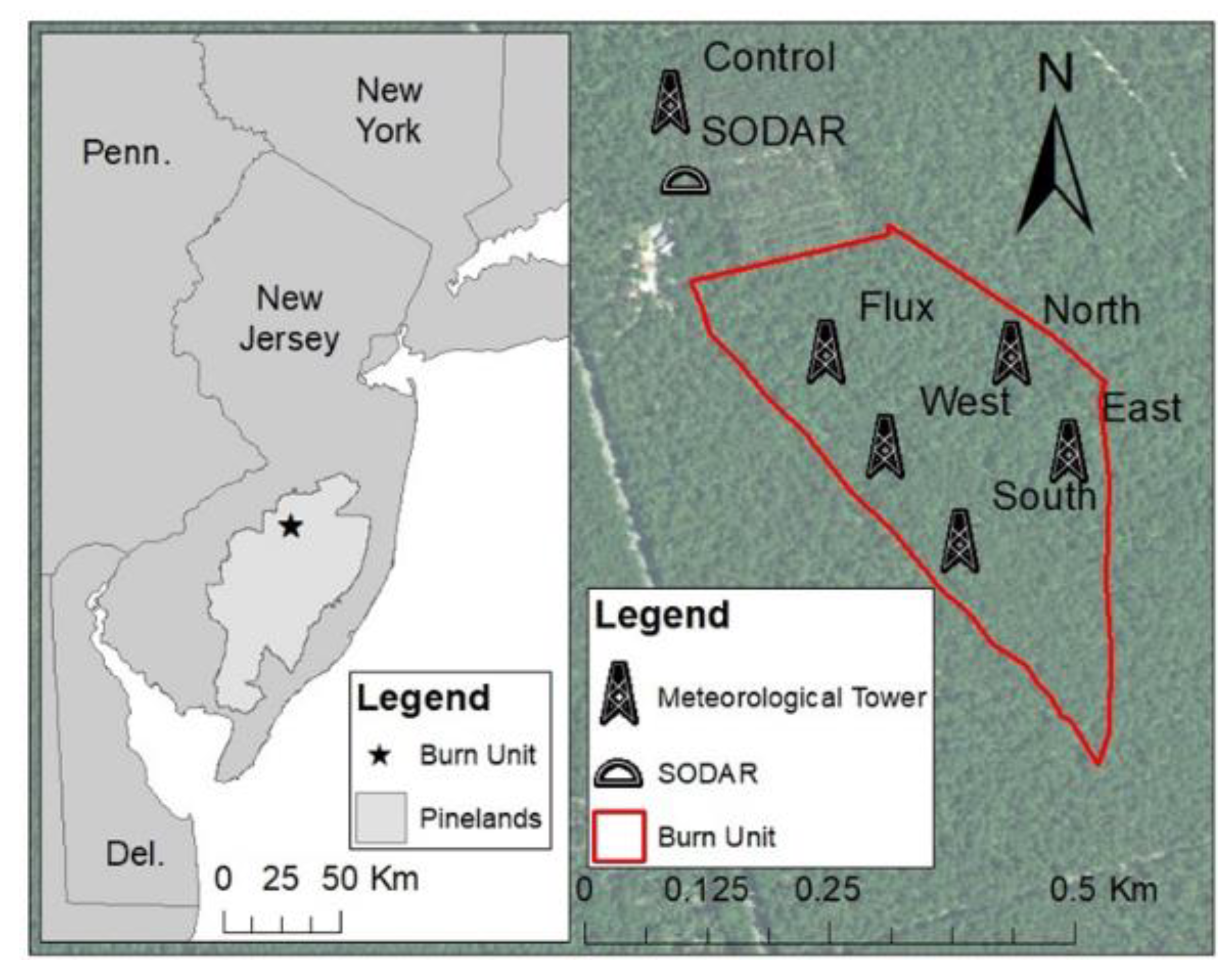

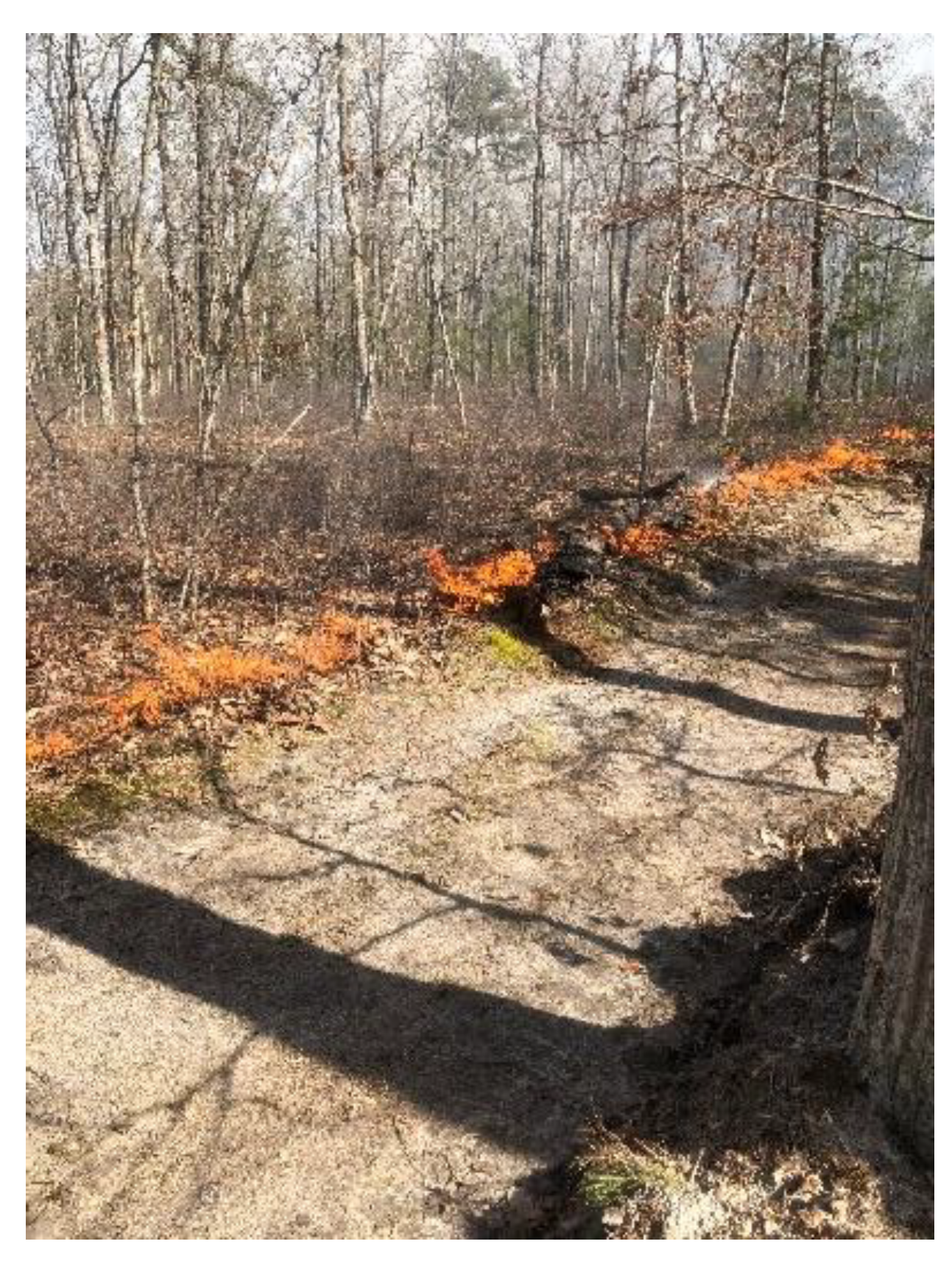

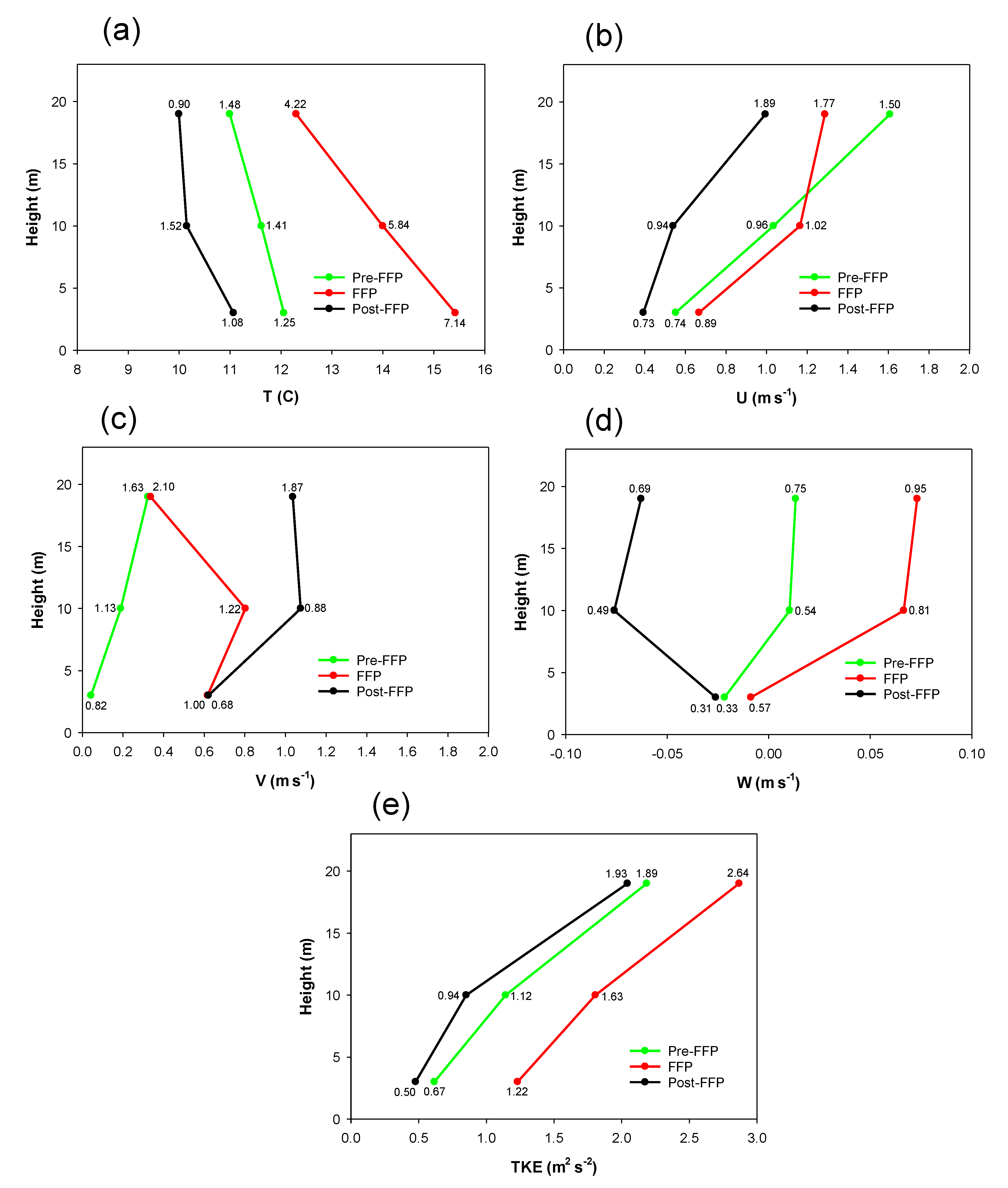
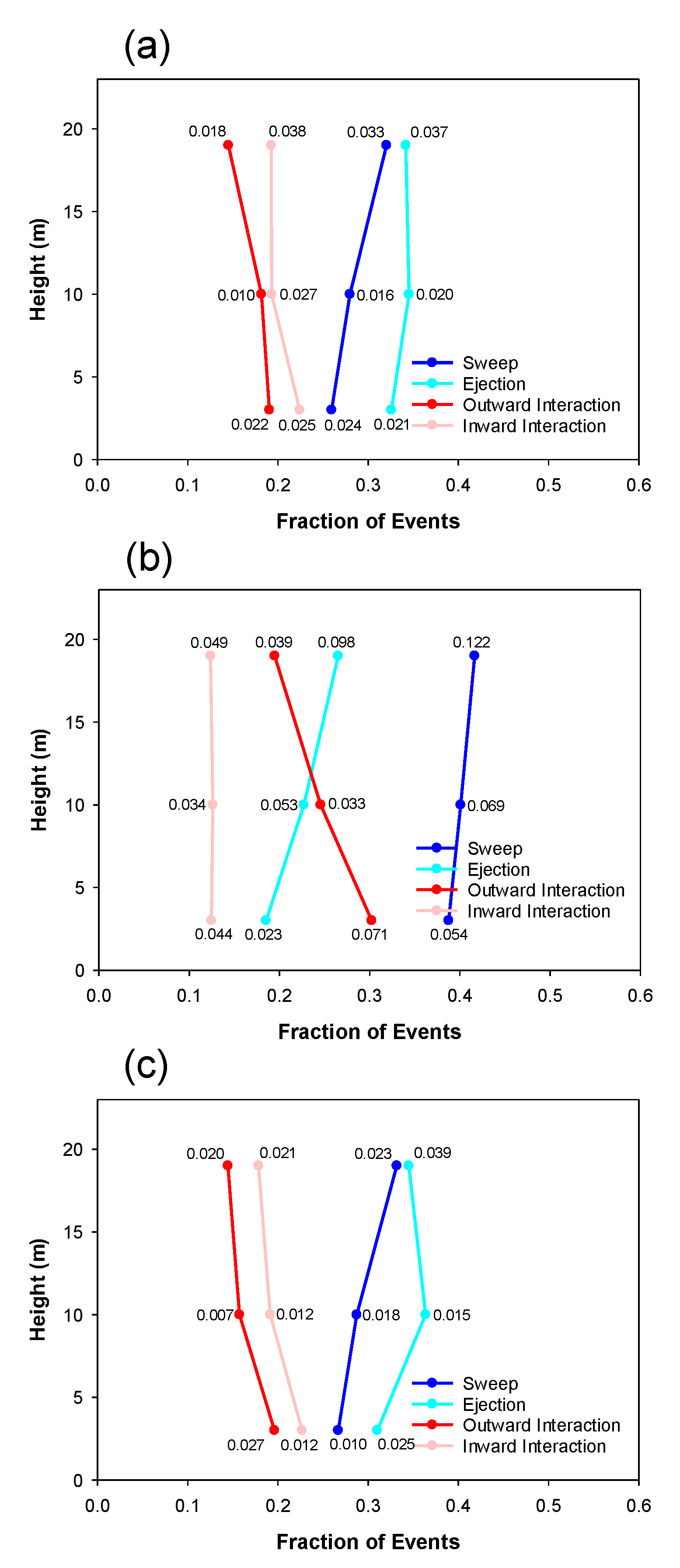
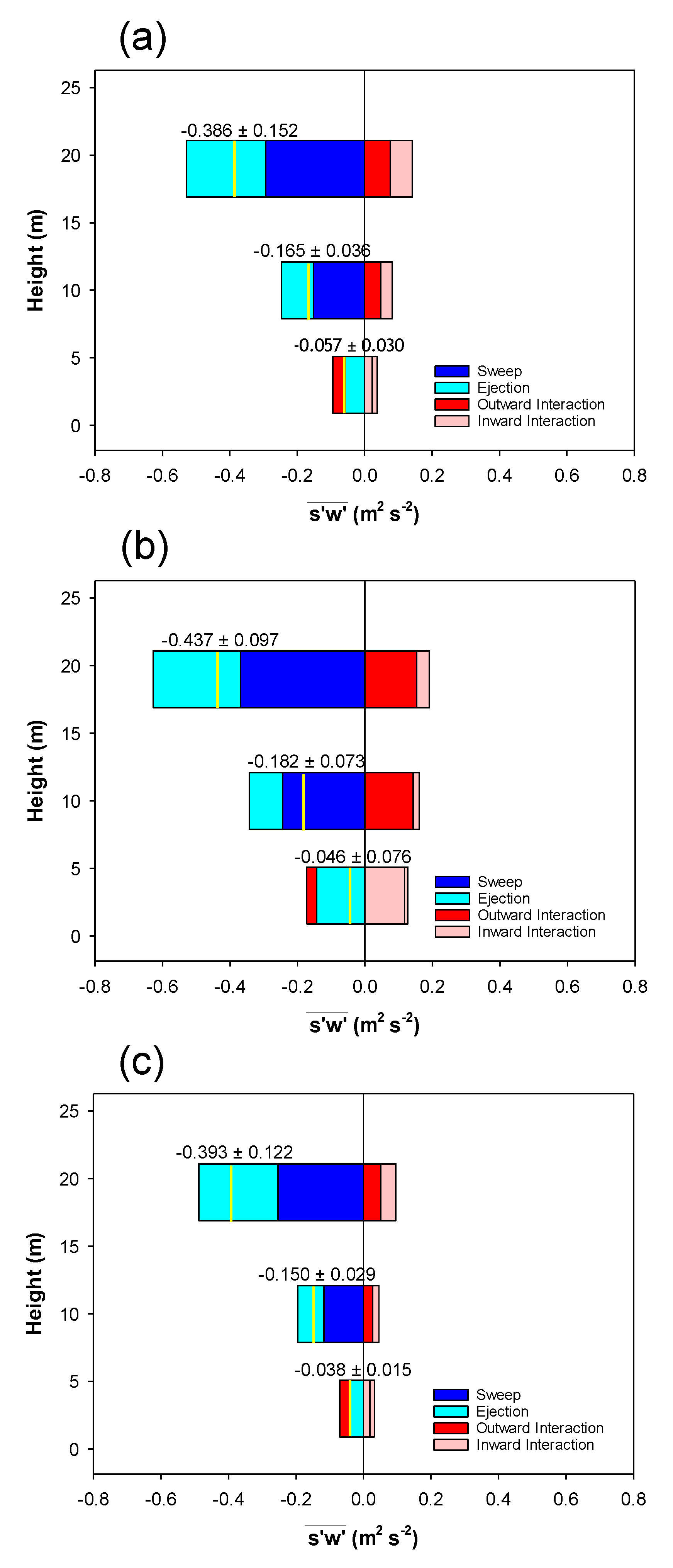
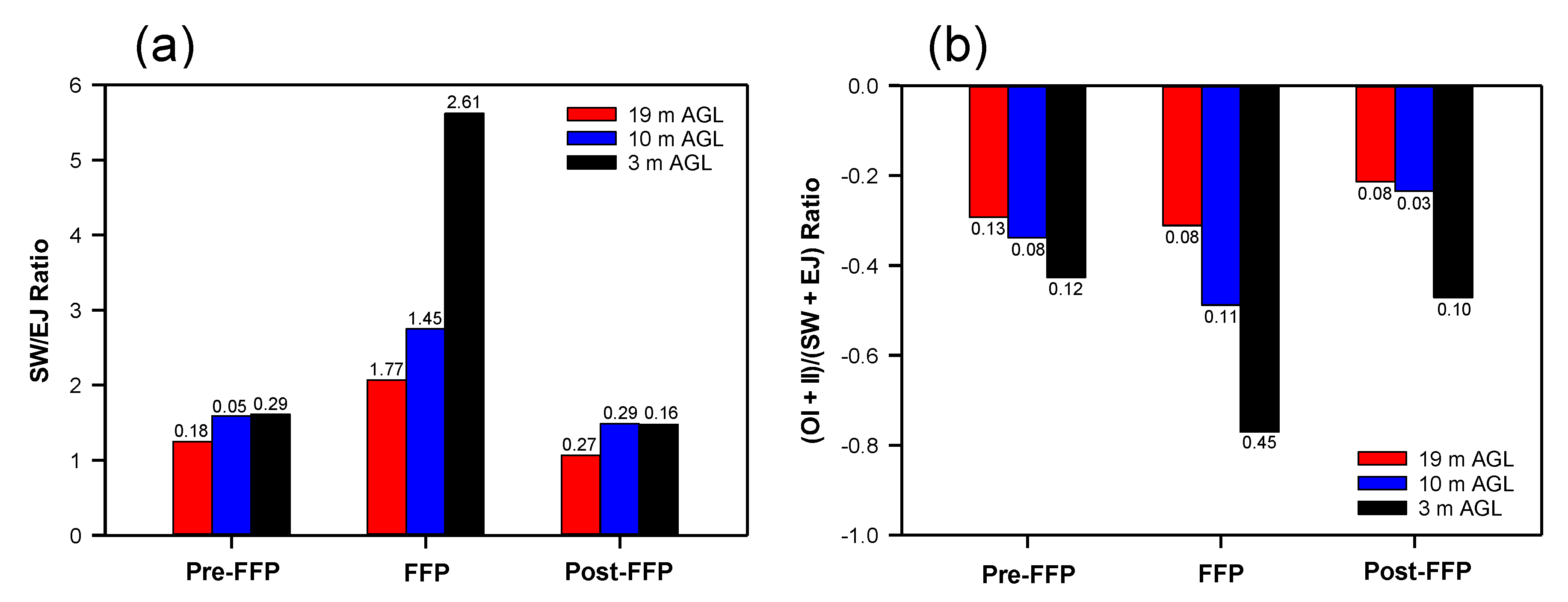
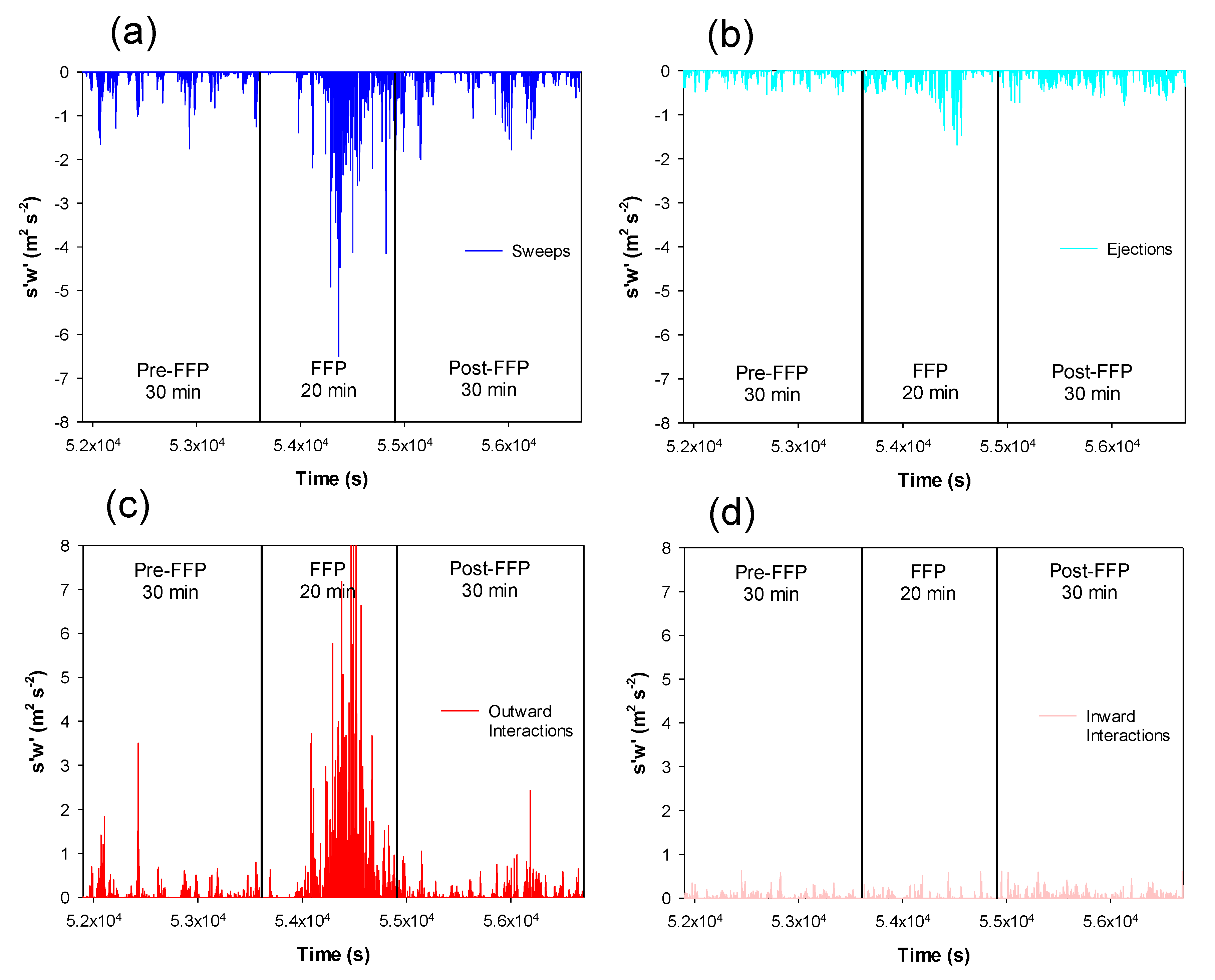

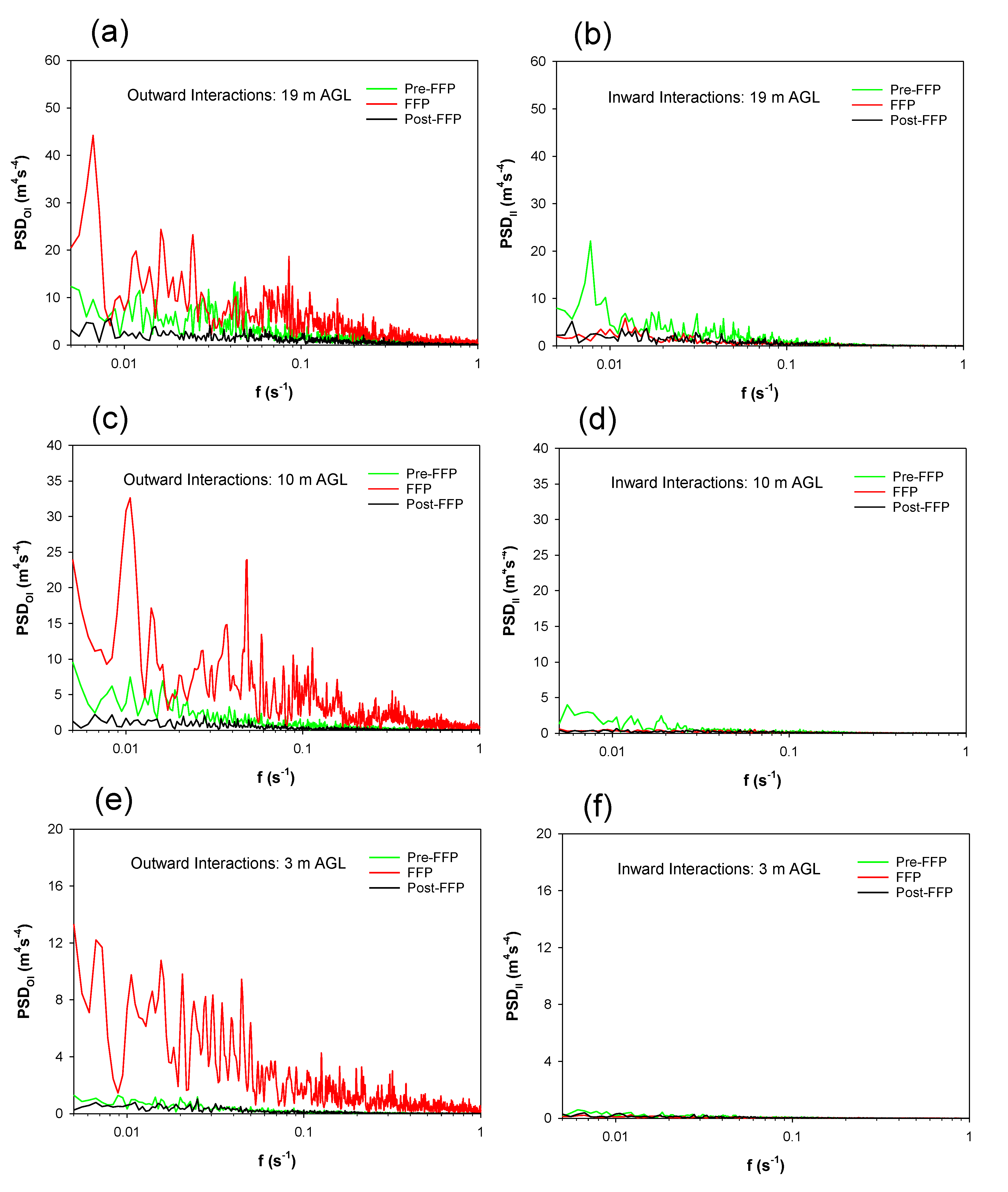
| Tower | Pre-FFP | FFP | Post-FFP |
|---|---|---|---|
| South | 1425–1455 | 1455–1515 | 1515–1545 |
| West | 1455–1525 | 1525–1545 | 1545–1615 |
| Flux | 1455–1525 | 1525–1540 | 1540–1610 |
| East | 1508–1538 | 1538–1553 | 1553–1623 |
| North | 1543–1613 | 1613–1633 | 1633–1703 |
| Variable | Pre-FFP | FFP | Post-FFP | ||||||
|---|---|---|---|---|---|---|---|---|---|
| 3 m | 10 m | 19 m | 3 m | 10 m | 19 m | 3 m | 10 m | 19 m | |
| [] | 0.53 | 0.90 | 2.12 | 0.80 | 1.14 | 2.63 | 0.44 | 0.81 | 1.67 |
| [] | 0.59 | 1.09 | 1.69 | 1.36 | 1.82 | 2.20 | 0.42 | 0.66 | 1.94 |
| [] | 0.11 | 0.29 | 0.56 | 0.31 | 0.66 | 0.91 | 0.09 | 0.23 | 0.47 |
| [] | 0.14 | 0.18 | 0.19 | 0.16 | 0.23 | 0.21 | 0.15 | 0.19 | 0.17 |
| [] | −0.05 | −0.01 | −0.10 | −0.13 | −0.23 | −0.58 | −0.09 | −0.12 | −0.40 |
| [] | −0.07 | −0.14 | −0.30 | −0.03 | −0.18 | −0.29 | −0.03 | −0.07 | −0.15 |
| [] | −0.01 | −0.09 | −0.06 | −0.01 | −0.04 | 0.01 | 0.00 | −0.10 | −0.17 |
| [] | −0.02 | −0.02 | −0.14 | 1.15 | 0.12 | −0.56 | 0.01 | 0.05 | −0.02 |
| [] | 0.07 | 0.17 | 0.11 | 2.40 | 0.94 | −0.23 | −0.13 | −0.24 | −0.31 |
| [] | 0.12 | 0.26 | 0.43 | 1.85 | 2.93 | 2.75 | 0.09 | 0.08 | 0.16 |
| [] | 0.10 | 0.18 | 0.23 | 0.72 | 0.55 | 0.02 | −0.03 | 0.09 | −0.09 |
| [] | 0.32 | 0.42 | 0.29 | 0.90 | 0.68 | 0.19 | 0.09 | 0.39 | 0.49 |
| [] | −0.46 | −0.16 | 0.08 | 0.31 | 0.74 | 0.86 | −0.40 | −0.72 | −0.21 |
Publisher’s Note: MDPI stays neutral with regard to jurisdictional claims in published maps and institutional affiliations. |
© 2021 by the authors. Licensee MDPI, Basel, Switzerland. This article is an open access article distributed under the terms and conditions of the Creative Commons Attribution (CC BY) license (https://creativecommons.org/licenses/by/4.0/).
Share and Cite
Heilman, W.E.; Clark, K.L.; Bian, X.; Charney, J.J.; Zhong, S.; Skowronski, N.S.; Gallagher, M.R.; Patterson, M. Turbulent Momentum Flux Behavior above a Fire Front in an Open-Canopied Forest. Atmosphere 2021, 12, 956. https://doi.org/10.3390/atmos12080956
Heilman WE, Clark KL, Bian X, Charney JJ, Zhong S, Skowronski NS, Gallagher MR, Patterson M. Turbulent Momentum Flux Behavior above a Fire Front in an Open-Canopied Forest. Atmosphere. 2021; 12(8):956. https://doi.org/10.3390/atmos12080956
Chicago/Turabian StyleHeilman, Warren E., Kenneth L. Clark, Xindi Bian, Joseph J. Charney, Shiyuan Zhong, Nicholas S. Skowronski, Michael R. Gallagher, and Matthew Patterson. 2021. "Turbulent Momentum Flux Behavior above a Fire Front in an Open-Canopied Forest" Atmosphere 12, no. 8: 956. https://doi.org/10.3390/atmos12080956
APA StyleHeilman, W. E., Clark, K. L., Bian, X., Charney, J. J., Zhong, S., Skowronski, N. S., Gallagher, M. R., & Patterson, M. (2021). Turbulent Momentum Flux Behavior above a Fire Front in an Open-Canopied Forest. Atmosphere, 12(8), 956. https://doi.org/10.3390/atmos12080956







